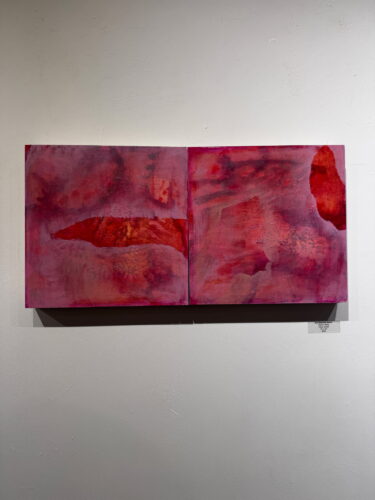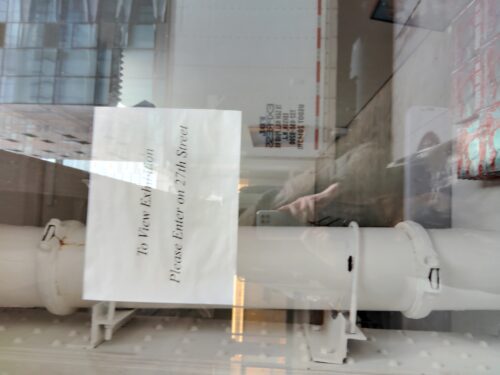I need it.
We need it.
The planet needs it.
Wisdom, power, beauty. We seek for them in the natural world as well as in art. It does not seem coincidental that our institutional cultural settings are under attack by the same forces as our environment. Chelsea has become a place where we are called to draw a line.
Which brings me to a breezy Saturday afternoon seeing a very intriguing book in a window of 28th Street along with a sign directing me to “enter of 27th Street.” And of course, it started on Thursday.
“It’s Spring, tease me!” I asked New York City’s most iconic and evolving gallery district to do that for me, and it didn’t disappoint. Chelsea had its first big Thursday of this season, and if the crowds doing the crawl are any indication, our culture is alive and well. For now, anyway.
The vibe was alive, but it was a tough night for actual viewing. My first stop, hoping to catch up with Brooklyn artist Kristin Reed, was Atlantic Gallery, where artist members had invited other artists to exhibit in their annual Connections exhibition.
Good news! I saw Kristin along with the artist who invited her, whose work I admire, Roni Sherman Ramos. Bad news? Not exactly, it’s wonderful to see a solid gallery for practicing artists packed with enthusiastic art lovers, but I actually couldn’t get a good look at any of the work. Art has survived the pandemic, with some new looks and fresh audiences, and also reminiscent of the days when artists had a hard time getting into their own openings.
Ever hopeful, I decided to save that building for a return visit and catch the last minutes of the reception nearby at Hollis Taggart Gallery. An enticing list of names adjacent to a pair of silver shoes by Yayoi Kusama announced, “Take Notice,” an exhibition honoring “the diverse group of women artists, past and present, who have contributed to the gallery’s programming for over 45 years.” And enticement it would remain for that night, as the ever-burgeoning crowd barely left room for a glimpse inside the gallery.
Which brings me back to that windy Saturday and the enticing sign in that near empty storefront. Years of writing up my adventures in and around art have taught me to never bypass a mystery… but I was on 28th specifically to return to #528, an interesting building itself, a longtime home to galleries and studios served by a very neat crossover to the building’s 527 West 27th Street entrance.
After walking through Atlantic and soaking in the depths of talent and ultra-high vibes of a show that truly represents artists as who we are – a community, I was drawn by light, color and texture into Luz Art Gallery, to view Laura Lea’s heartfelt and literally illuminating sculptural works. Following the artist’s personal journey, they tell a story and create a meditative space that made me not want to leave, or maybe take a bit home with me…
Crossing over to the downtown entrance, which you can do on floors 5 and 6, I popped into Blue Mountain Gallery, where Suzanne Lacke’s paintings and drawings spanning 50 years present an eclectic exploration of a wide range of subjects. The street scenes were magnets to my imagination, viewing them gives a real sense of time, place, weather and leaves you guessing about what the artist, standing where the viewer is now, is thinking.
Now it was time to see what awaited me at 507 West 27th, a spacious gallery adjacent to that irresistible 28th Street window. “Art must be ecological. Art must be political. Art is always performative and activist.
” Klaus Biesenbach, from the book, “Mother Nature in the Bardo”.
I entered the first gallery of the exhibition and was swept away (no, seriously, I was walking around whispering oh, my God and oh wow and holy… well, you get it) by monumental, exceptional and captivating pieces, all intent upon owning their own impact and succeeding at it. And there were several more galleries, featuring artists spanning the 19th century (including a collection of Hudson River School works) to the present day. All in service of a noble concept.
“Since humanity’s beginning, art, culture, and nature have influenced one another profoundly,” writes Evanly Schindler, publisher of Mother Nature In The Bardo and presenter of the exhibition.
“Right now, polarizing conversations about the environment dominate news and social media, arguably the most crucial conversations of our time climate change, sustainability, conservation, energy alternatives, consumption, waste, recycling, our forests, farms, land, and seas.
“Mother Nature in the Bardo’s curation focuses on these topics, starting with the modern and contemporary eras beginning about 200 years ago. With the second and third industrial revolutions in full swing, art, culture, and the environment met at a crossroads that would forever change their paths, and artists responded in kind. The Impressionists and Post-Impressionists were a reaction away from 18th and 19th century traditional and academic values and the changing landscape from the impact of industrialization. Artists went outside to paint, “En plein air”, to reflect their modern values and created some of the most famous and valuable art.
“The Bardo (from the Buddhist word bahr-do) refers to the transitional state or gap between any two states. The Bardo and other spiritual constructs are inherent in conversations about the current existential crisis facing the environment and echo the ideas of the artists throughout this book. The underlying message of Mother Nature in the Bardo is the precarious and transitional state of the environment in our era, and the collective hope and inspiration of the artists, and all of us, that she (Mother Nature) transitions to a higher ground, be it heaven, Eden, nirvana, or the promised land. “speak to all of us in a way that is so immediate and so direct, we change our behavior. Today, we experience climate disasters almost every day around the world. And while we experience climate change, every one of us, we also experience a collective sadness, isolation, and powerlessness. We must find something positive in both artistic and scientific creativity to solve this crisis.” On view through April 30th.
A large part of the way art transforms our lives is totally ephemeral. We never see that painting for the first time again. That group show will never be back just the same as it was, and the catalog just has to suffice. But Chelsea always has a surprise around the corner.
Speaking of which, on 26th Street I did manage a look at Take Notice, presented by Hollis Taggart in honor of Women’s History Month. The visuals were every bit as eclectic and energizing as promised by the list of artists, worth catching before it closes on the 19th. On the same block, the National Academy maintains an exhibition space for its ongoing programming after relocating from Museum Mile, bringing a spark to Chelsea that is uptown’s loss.
Currently they are presenting: “A two-part exhibition, Past as Prologue: A Historical Acknowledgment represents the National Academy of Design’s efforts towards a critical reassessment of the cultural context in which the Academy was founded. The National Academy of Design was initiated by artists and architects to fill a void in the American artistic landscape of the 19th century, but we recognize our history has excluded many communities and cultures whose lineages and practices must be included in this country’s art historical canon: Indigenous peoples, people of color, queer and nonbinary individuals and people with different abilities. We are committed to a process of dismantling the ongoing legacies of settler colonialism and white supremacy.”
“Beware of artists they mix with all classes of society and are therefore the most dangerous,” is a quote often attributed to Queen Victoria. I believe she would have found Chelsea to be quite perilous, then. Once again quoting Klaus Biesenbach, from the book: “Gerhard Richter puts it: Art is the highest form of hope. And creativity is perhaps the only way out we have.”
Call it magic. It’s the DNA of the Chelsea art community. The question is just how endangered a species is that?
To be continued.
www.atlanticgallery.org, www.bluemountaingallery.org, www.hollistaggart.com, wwwnationalacademy.org/calendar/Past-As-Prologue-Part-II





